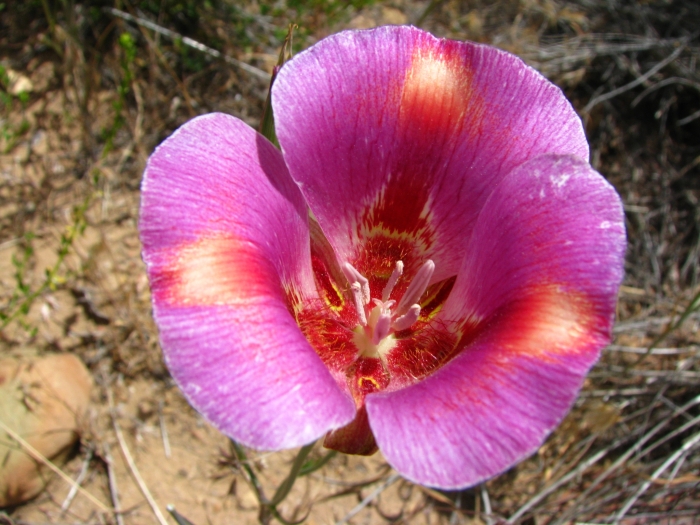Butterfly Mariposa Lily
(Calochortus venustus)
Butterfly Mariposa Lily (Calochortus venustus)
/
/

Zack Abbey
CC BY 4.0
Image By:
Zack Abbey
Recorded By:
Copyright:
CC BY 4.0
Copyright Notice:
Photo by: Zack Abbey | License Type: CC BY 4.0 | License URL: http://creativecommons.org/licenses/by/4.0/ | Rights Holder: Zack Abbey | Publisher: iNaturalist | Date Created: 2010-05-28T11:50:53-07:00 |
























Estimated Native Range
Summary
Calochortus venustus, commonly known as Butterfly Mariposa Lily, is a perennial herb native to California’s diverse ecosystems, including grasslands, open woodlands, and chaparral, at elevations of 984-8858 feet (300-2700 meters). It is particularly adapted to the Mediterranean climate of the region, with its wet winters and dry summers. This species typically features grass-like leaves and stems reaching up to 24 inches tall, with bulbs that lie dormant during the dry season.
The Butterfly Mariposa Lily is celebrated for its large, showy flowers that bloom from late spring to early summer. The flowers exhibit a stunning array of colors—white, pink, purple, red, and orange—with intricate patterns that attract pollinators. Each flower has three sepals and three distinctive clawed petals, which give it a unique, ornate appearance. The fruit is an angled capsule that follows the flowering period. In cultivation, this plant is valued for its drought tolerance and striking floral display, making it a favorite in native plant gardens, rock gardens, and as a naturalizing element in informal settings. It thrives in light, sandy soils with good drainage and requires full sun exposure to flourish. While generally low-maintenance, it can be susceptible to bulb rot if overwatered or planted in poorly drained soils.CC BY-SA 4.0
The Butterfly Mariposa Lily is celebrated for its large, showy flowers that bloom from late spring to early summer. The flowers exhibit a stunning array of colors—white, pink, purple, red, and orange—with intricate patterns that attract pollinators. Each flower has three sepals and three distinctive clawed petals, which give it a unique, ornate appearance. The fruit is an angled capsule that follows the flowering period. In cultivation, this plant is valued for its drought tolerance and striking floral display, making it a favorite in native plant gardens, rock gardens, and as a naturalizing element in informal settings. It thrives in light, sandy soils with good drainage and requires full sun exposure to flourish. While generally low-maintenance, it can be susceptible to bulb rot if overwatered or planted in poorly drained soils.CC BY-SA 4.0
Plant Description
- Plant Type: Herb, Bulb
- Height: 0.5-2 feet
- Width: 0.5-1 feet
- Growth Rate: Moderate
- Flower Color: Cream, Pink, Purple, Red, White, Yellow
- Flowering Season: Spring, Summer
- Leaf Retention: Deciduous
Growth Requirements
- Sun: Full Sun, Part Shade
- Water: Medium
- Drainage: Fast, Medium
Common Uses
Bee Garden, Butterfly Garden, Deer Resistant, Drought Tolerant, Low Maintenance
Natural Habitat
Native to California’s grasslands, open woodlands, and chaparral within a Mediterranean climate
Other Names
Common Names: Beautiful Mariposa Lily
Scientific Names: , Calochortus venustus, Calochortus venustus, Calochortus venustus subsp. pictus, Calochortus venustus var. caroli, Calochortus venustus var. eldorado, Calochortus venustus var. oculatus, Calochortus venustus var. pictus, Calochortus venustus var. purpurascens, Calochortus venustus var. purpurascens
GBIF Accepted Name: